Xin Tian
Mamba-Based Ensemble learning for White Blood Cell Classification
Apr 15, 2025Abstract:White blood cell (WBC) classification assists in assessing immune health and diagnosing various diseases, yet manual classification is labor-intensive and prone to inconsistencies. Recent advancements in deep learning have shown promise over traditional methods; however, challenges such as data imbalance and the computational demands of modern technologies, such as Transformer-based models which do not scale well with input size, limit their practical application. This paper introduces a novel framework that leverages Mamba models integrated with ensemble learning to improve WBC classification. Mamba models, known for their linear complexity, provide a scalable alternative to Transformer-based approaches, making them suitable for deployment in resource-constrained environments. Additionally, we introduce a new WBC dataset, Chula-WBC-8, for benchmarking. Our approach not only validates the effectiveness of Mamba models in this domain but also demonstrates their potential to significantly enhance classification efficiency without compromising accuracy. The source code can be found at https://github.com/LewisClifton/Mamba-WBC-Classification.
Multimodal Image Matching based on Frequency-domain Information of Local Energy Response
Mar 26, 2025Abstract:Complicated nonlinear intensity differences, nonlinear local geometric distortions, noises and rotation transformation are main challenges in multimodal image matching. In order to solve these problems, we propose a method based on Frequency-domain Information of Local Energy Response called FILER. The core of FILER is the local energy response model based on frequency-domain information, which can overcome the effect of nonlinear intensity differences. To improve the robustness to local nonlinear geometric distortions and noises, we design a new edge structure enhanced feature detector and convolutional feature weighted descriptor, respectively. In addition, FILER overcomes the sensitivity of the frequency-domain information to the rotation angle and achieves rotation invariance. Extensive experiments multimodal image pairs show that FILER outperforms other state-of-the-art algorithms and has good robustness and universality.
SpatialMe: Stereo Video Conversion Using Depth-Warping and Blend-Inpainting
Dec 16, 2024Abstract:Stereo video conversion aims to transform monocular videos into immersive stereo format. Despite the advancements in novel view synthesis, it still remains two major challenges: i) difficulty of achieving high-fidelity and stable results, and ii) insufficiency of high-quality stereo video data. In this paper, we introduce SpatialMe, a novel stereo video conversion framework based on depth-warping and blend-inpainting. Specifically, we propose a mask-based hierarchy feature update (MHFU) refiner, which integrate and refine the outputs from designed multi-branch inpainting module, using feature update unit (FUU) and mask mechanism. We also propose a disparity expansion strategy to address the problem of foreground bleeding. Furthermore, we conduct a high-quality real-world stereo video dataset -- StereoV1K, to alleviate the data shortage. It contains 1000 stereo videos captured in real-world at a resolution of 1180 x 1180, covering various indoor and outdoor scenes. Extensive experiments demonstrate the superiority of our approach in generating stereo videos over state-of-the-art methods.
Enhancing Text-to-SQL Capabilities of Large Language Models via Domain Database Knowledge Injection
Sep 24, 2024Abstract:Text-to-SQL is a subtask in semantic parsing that has seen rapid progress with the evolution of Large Language Models (LLMs). However, LLMs face challenges due to hallucination issues and a lack of domain-specific database knowledge(such as table schema and cell values). As a result, they can make errors in generating table names, columns, and matching values to the correct columns in SQL statements. This paper introduces a method of knowledge injection to enhance LLMs' ability to understand schema contents by incorporating prior knowledge. This approach improves their performance in Text-to-SQL tasks. Experimental results show that pre-training LLMs on domain-specific database knowledge and fine-tuning them on downstream Text-to-SQL tasks significantly improves the Execution Match (EX) and Exact Match (EM) metrics across various models. This effectively reduces errors in generating column names and matching values to the columns. Furthermore, the knowledge-injected models can be applied to many downstream Text-to-SQL tasks, demonstrating the generalizability of the approach presented in this paper.
The Quest for Early Detection of Retinal Disease: 3D CycleGAN-based Translation of Optical Coherence Tomography into Confocal Microscopy
Aug 07, 2024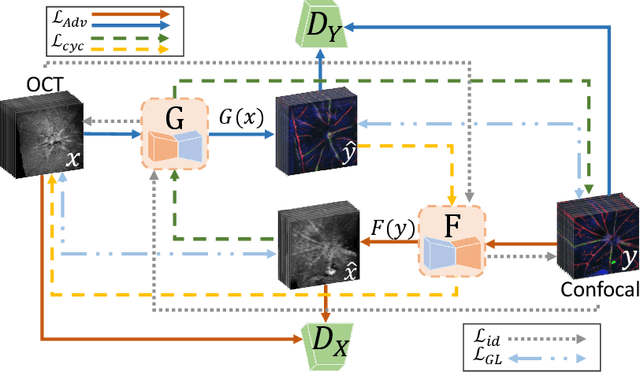



Abstract:Optical coherence tomography (OCT) and confocal microscopy are pivotal in retinal imaging, offering distinct advantages and limitations. In vivo OCT offers rapid, non-invasive imaging but can suffer from clarity issues and motion artifacts, while ex vivo confocal microscopy, providing high-resolution, cellular-detailed color images, is invasive and raises ethical concerns. To bridge the benefits of both modalities, we propose a novel framework based on unsupervised 3D CycleGAN for translating unpaired in vivo OCT to ex vivo confocal microscopy images. This marks the first attempt to exploit the inherent 3D information of OCT and translate it into the rich, detailed color domain of confocal microscopy. We also introduce a unique dataset, OCT2Confocal, comprising mouse OCT and confocal retinal images, facilitating the development of and establishing a benchmark for cross-modal image translation research. Our model has been evaluated both quantitatively and qualitatively, achieving Fr\'echet Inception Distance (FID) scores of 0.766 and Kernel Inception Distance (KID) scores as low as 0.153, and leading subjective Mean Opinion Scores (MOS). Our model demonstrated superior image fidelity and quality with limited data over existing methods. Our approach effectively synthesizes color information from 3D confocal images, closely approximating target outcomes and suggesting enhanced potential for diagnostic and monitoring applications in ophthalmology.
TaGAT: Topology-Aware Graph Attention Network For Multi-modal Retinal Image Fusion
Jul 19, 2024


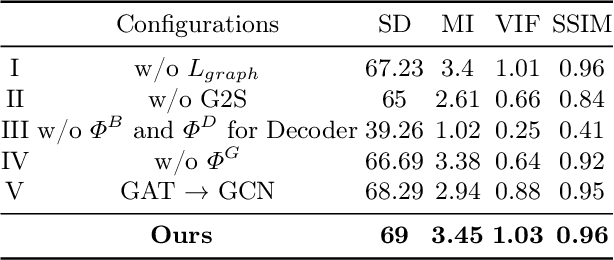
Abstract:In the realm of medical image fusion, integrating information from various modalities is crucial for improving diagnostics and treatment planning, especially in retinal health, where the important features exhibit differently in different imaging modalities. Existing deep learning-based approaches insufficiently focus on retinal image fusion, and thus fail to preserve enough anatomical structure and fine vessel details in retinal image fusion. To address this, we propose the Topology-Aware Graph Attention Network (TaGAT) for multi-modal retinal image fusion, leveraging a novel Topology-Aware Encoder (TAE) with Graph Attention Networks (GAT) to effectively enhance spatial features with retinal vasculature's graph topology across modalities. The TAE encodes the base and detail features, extracted via a Long-short Range (LSR) encoder from retinal images, into the graph extracted from the retinal vessel. Within the TAE, the GAT-based Graph Information Update (GIU) block dynamically refines and aggregates the node features to generate topology-aware graph features. The updated graph features with base and detail features are combined and decoded as a fused image. Our model outperforms state-of-the-art methods in Fluorescein Fundus Angiography (FFA) with Color Fundus (CF) and Optical Coherence Tomography (OCT) with confocal microscopy retinal image fusion. The source code can be accessed via https://github.com/xintian-99/TaGAT.
Hybrid Spatial-spectral Neural Network for Hyperspectral Image Denoising
Jun 13, 2024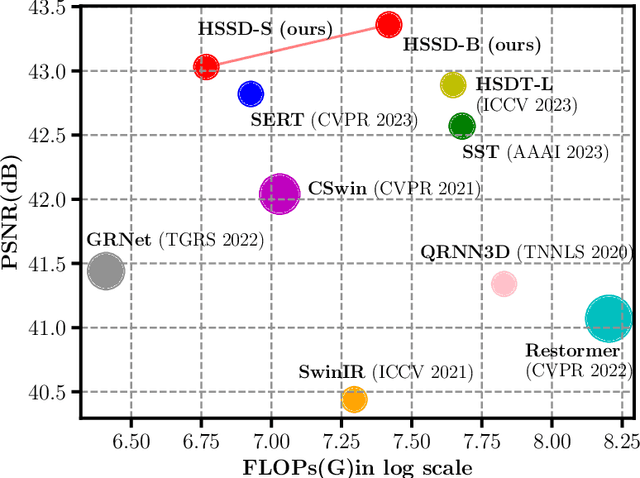
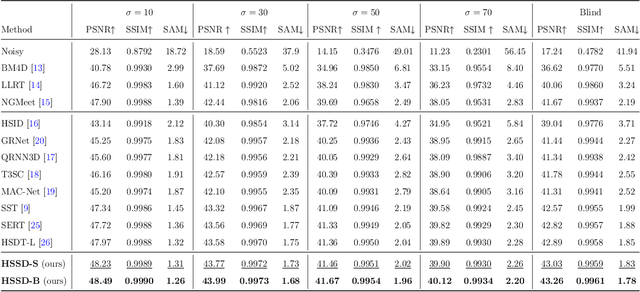
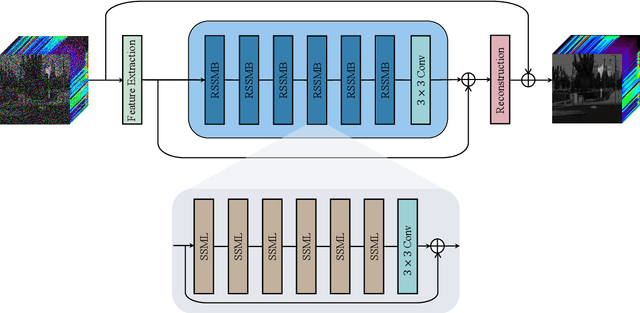
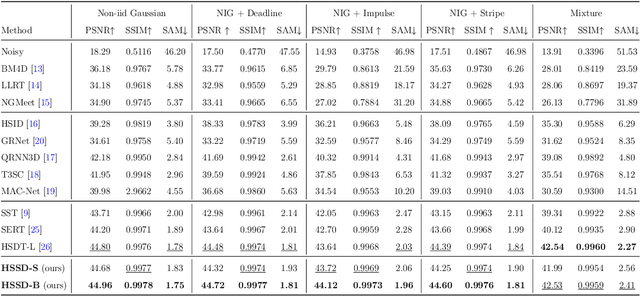
Abstract:Hyperspectral image (HSI) denoising is an essential procedure for HSI applications. Unfortunately, the existing Transformer-based methods mainly focus on non-local modeling, neglecting the importance of locality in image denoising. Moreover, deep learning methods employ complex spectral learning mechanisms, thus introducing large computation costs. To address these problems, we propose a hybrid spatial-spectral denoising network (HSSD), in which we design a novel hybrid dual-path network inspired by CNN and Transformer characteristics, leading to capturing both local and non-local spatial details while suppressing noise efficiently. Furthermore, to reduce computational complexity, we adopt a simple but effective decoupling strategy that disentangles the learning of space and spectral channels, where multilayer perception with few parameters is utilized to learn the global correlations among spectra. The synthetic and real experiments demonstrate that our proposed method outperforms state-of-the-art methods on spatial and spectral reconstruction. The code and details are available on https://github.com/HLImg/HSSD.
OCT2Confocal: 3D CycleGAN based Translation of Retinal OCT Images to Confocal Microscopy
Nov 26, 2023Abstract:Optical coherence tomography (OCT) and confocal microscopy are pivotal in retinal imaging, each presenting unique benefits and limitations. In vivo OCT offers rapid, non-invasive imaging but can be hampered by clarity issues and motion artifacts. Ex vivo confocal microscopy provides high-resolution, cellular detailed color images but is invasive and poses ethical concerns and potential tissue damage. To bridge these modalities, we developed a 3D CycleGAN framework for unsupervised translation of in vivo OCT to ex vivo confocal microscopy images. Applied to our OCT2Confocal dataset, this framework effectively translates between 3D medical data domains, capturing vascular, textural, and cellular details with precision. This marks the first attempt to exploit the inherent 3D information of OCT and translate it into the rich, detailed color domain of confocal microscopy. Assessed through quantitative and qualitative metrics, the 3D CycleGAN framework demonstrates commendable image fidelity and quality, outperforming existing methods despite the constraints of limited data. This non-invasive generation of retinal confocal images has the potential to further enhance diagnostic and monitoring capabilities in ophthalmology.
A Canonical Data Transformation for Achieving Inter- and Within-group Fairness
Oct 23, 2023Abstract:Increases in the deployment of machine learning algorithms for applications that deal with sensitive data have brought attention to the issue of fairness in machine learning. Many works have been devoted to applications that require different demographic groups to be treated fairly. However, algorithms that aim to satisfy inter-group fairness (also called group fairness) may inadvertently treat individuals within the same demographic group unfairly. To address this issue, we introduce a formal definition of within-group fairness that maintains fairness among individuals from within the same group. We propose a pre-processing framework to meet both inter- and within-group fairness criteria with little compromise in accuracy. The framework maps the feature vectors of members from different groups to an inter-group-fair canonical domain before feeding them into a scoring function. The mapping is constructed to preserve the relative relationship between the scores obtained from the unprocessed feature vectors of individuals from the same demographic group, guaranteeing within-group fairness. We apply this framework to the COMPAS risk assessment and Law School datasets and compare its performance in achieving inter-group and within-group fairness to two regularization-based methods.
Query Enhanced Knowledge-Intensive Conversation via Unsupervised Joint Modeling
Dec 19, 2022Abstract:The quality of knowledge retrieval is crucial in knowledge-intensive conversations. Two common strategies to improve the retrieval quality are finetuning the retriever or generating a self-contained query, while they encounter heavy burdens on expensive computation and elaborate annotations. In this paper, we propose an unsupervised query enhanced approach for knowledge-intensive conversations, namely QKConv. There are three modules in QKConv: a query generator, an off-the-shelf knowledge selector, and a response generator. Without extra supervision, the end-to-end joint training of QKConv explores multiple candidate queries and utilizes corresponding selected knowledge to yield the target response. To evaluate the effectiveness of the proposed method, we conducted comprehensive experiments on conversational question-answering, task-oriented dialogue, and knowledge-grounded conversation. Experimental results demonstrate that QKConv achieves state-of-the-art performance compared to unsupervised methods and competitive performance compared to supervised methods.
 Add to Chrome
Add to Chrome Add to Firefox
Add to Firefox Add to Edge
Add to Edge